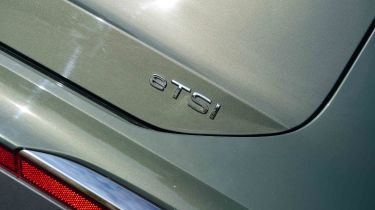Volkswagen Tiguan - MPG, emissions & running costs
Diesel power will be attractive to long-distance drivers, while the eHybrid offers stunning economy figures

Premium aspirations mean that Volkswagen Tiguan prices are steeper than they are for some rivals, although they’re still below the likes of the BMW X3 and Mercedes GLC.
Economy figures for the engine range start with a combined figure of 46.3mpg for the 1.5 eTSI 130, while the more powerful 1.5 eTSI 150 has a slightly poorer quoted figure of 45.3mpg. These economy figures beat those of the rival Ford Kuga, Hyundai Tucson and Kia Sportage when equipped with similarly sized petrol engines.
The larger 2.0 TSI petrol is thirstier and has the added drain of 4MOTION four-wheel drive. The 201bhp version manages 36.4mpg, while the more powerful model has a combined figure of only 33.2mpg. The 148bhp 2.0 TDI diesel is the most efficient non-plug-in Tiguan, returning up to 52.2mpg combined. As with all the other engines, this is the best combined figure that’s quoted by VW, and returns vary depending on trim level and wheel size.
The eHybrid version commands more money for its plug-in technology, but everyday running costs should be decent. VW quotes astronomical figures ranging from 647-715mpg for the plug-in hybrid Tiguans, but of course what you achieve in the real world will depend entirely on how often you charge the battery. Run it down, and once below 15 per cent capacity the PHEV’s electronics will favour petrol power to save the charge. Drive the Tiguan eHybrid like this, and you can expect fuel economy of around 35mpg. A small 45-litre fuel tank means the petrol range is short, which further emphasises the need to charge the battery on a regular basis.
| Model | MPG | CO2 | Insurance group |
| Tiguan 1.5 eTSI 130 DSG Life | 46.3mpg | 139g/km | 18E |
| Tiguan 1.5 eHybrid DSG Life | 706.2mpg | 9g/km | 27E |
| Tiguan 2.0 TDI 150 DSG Life | 52.3mpg | 141g/km | 22E |
Electric range, battery life and charge time
Keep the 25.7kWh pack (19.7kWh useable) topped up, and according to VW you should see an all-electric range of 77 miles from the 201bhp model, or 75 miles for the faster 268bhp car. When we tested the more powerful model in cold conditions, we saw a maximum range of 55 miles from the car’s trip computer, although this will change according to the type of driving that you do. That’s quite a lot further than the up to 42 miles you can get out of a 2.5 PHEV plug-in Ford Kuga.
Used - available now

2023 Volkswagen
Tiguan
13,750 milesAutomaticPetrol1.5L
Cash £25,000
2023 Volkswagen
Tiguan
38,980 milesAutomaticPetrol1.5L
Cash £22,100
2023 Volkswagen
Tiguan
32,504 milesAutomaticPetrol1.5L
Cash £22,800
2023 Volkswagen
Tiguan
21,662 milesAutomaticPetrol1.5L
Cash £24,000Volkswagen equips its eHybrid powertrain with fast DC charging of up to 50kW, and from a powerful enough source the battery can go from 10-80 per cent capacity in 26 minutes. The latest-generation PHEV system also has 11kW AC charging (up from 3.7kW before), which can take the battery from flat to full in two and a half hours.
Exclusively rapid charging your plug-in hybrid would be costly in the long run, so most people will likely utilise a 7.4kW wallbox charger at home. The official charging time at 7.4kW has yet to be released, but we expect it to be around four hours, a figure we’ve been given for the eHybrid Volkswagen Passat, which uses the same battery pack size.
The battery pack in the eHybrid model is covered by a separate warranty, which guarantees that the battery will maintain above 70 per cent capacity over five years or 100,000 miles. However, it only applies to the first owner of the car and is non-transferable to subsequent owners.
Tax
Official emissions figures of 9-10g/km for the Tiguan eHybrid mean it’s competitive as a company car thanks to being in a competitively low Benefit-in-Kind (BiK) company car tax bracket. The more powerful model has similar figures to the 201bhp version, although high list prices counter that.
All eHybrid models cost in excess of £40,000, as do the higher-powered 2.0 TSI petrol and the higher-sec diesels, so the luxury-car road tax premium is applied. The status of the eHybrid as a PHEV knocks a paltry £10 off the annual cost for the first five years.
Insurance groups
Adding a complex hybrid powertrain to the Tiguan sees insurance groups rise to the 27-31 range for the eHybrid variant, which is six or seven groups higher than the less powerful petrol and diesel models. The highest-ranked model is the most powerful 2.0 TSI, in Group 32.
For comparison, a Ford Kuga starts in group 16, and goes up to 26, while the Hyundai Tucson starts in group 18, before going up to group 24 for a top-of-the-range Ultimate PHEV with four-wheel drive.
Depreciation
Residual values in the 55 per cent bracket mean that the Tiguan eHybrid is a better performer than the combustion-engined versions of the car, which fall in the region of 50 to 53 per cent – the attraction of low company car costs is sure to help the eHybrid’s higher figures.
To get an accurate valuation of a specific model, check out our valuation tool...








